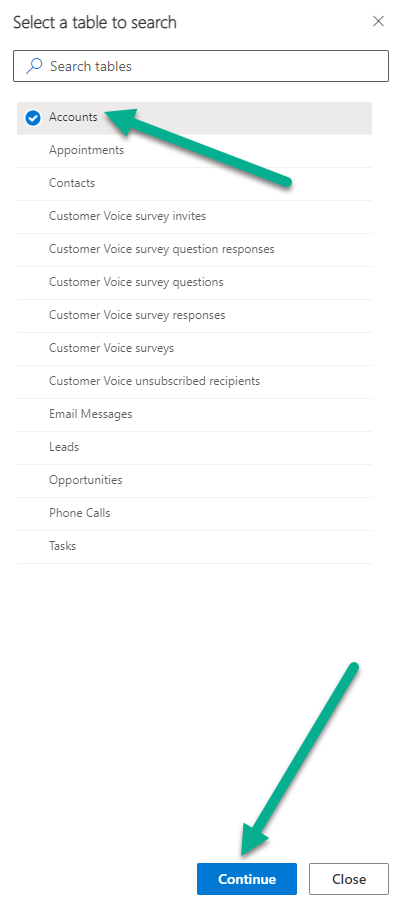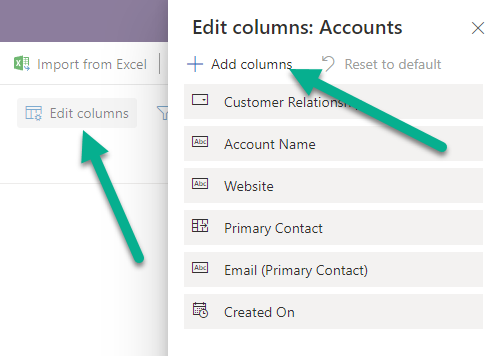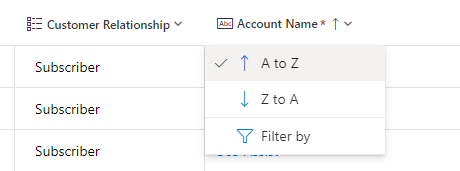*** NOTE: ALL INFORMATION IS ACCURATE AT DATE OF PUBLISHING ***
In case you missed it 2022 Release Wave 2 Plan documentation has been published. The modern advanced find isn’t new (it was added in Wave 1), but it will now be turned on by default from October 2022. I have worked with many clients where the classic Advanced Find has been left on, so I thought it might be a good idea to put together some information on how to turn it on ahead of time, and how it all works. I actually really like it, and hopefully you and your organisation will embrace it too!
First things first, a couple of admin items. If you want to turn it on, go to https://admin.powerplatform.microsoft.com/environments and then click on the right environment. Go to the Settings area and type the word Search in to the box. Click on the Search option that comes up.
Then scroll down to the Advanced find options and turn on the Modern advanced find in model-driven apps. The other option may or may not be one you want to turn on, but I will show you how it works. From a user perspective, I think it’s useful. There are System Views that might never be of any interest or relevance to me, so being able to hide them is very helpful.
So as a reminder, this is what a list of views looks like prior to turning on the new advanced find. We see My Views at the top then System Views below it. We have the option to set the view we are currently looking at as a default (user specific).
To access Advanced Find, we click on the filter icon from the top right of Dynamics 365.
After turning on the new advanced find, the list of views is slightly different. There is no separation of User and System views with a line, but views created by a user are identified by a little person icon. We also get a new option to manage and share views at the bottom.
Notice in the tool bar at the top, the Advanced Find filter icon is no longer there. So how do we get to it?
Simply click in the Search box at the top, and then click the option right at the bottom to open up the new advanced find.
The first thing to do is pick the table for the records you want to search for. Notice this list is pretty small. The tables must be part of the app that is being used by the person logged-in, in order to be available in the list. So the list you see below is from a custom app I have. The Marketing App shows other tables, while the Sales Hub shows different ones there too.
Now we can add rows to our filtering criteria, and also add related entities and filter further as needed. The interface is very easy to use. Notice there is a Download FetchXML option. This exists in the classic advanced find but it’s not as prominent.
If you have reasons for hiding this, you can find the permission in security roles under the Customisation tab then at the bottom in Miscellaneous Privileges.
Once you’ve added your filters, click the blue Apply button at the bottom. This will then show the results with the records that meet the filtered criteria. Now we can click on the Edit columns option from the top right of the view. This will open and show the current columns and the order the show in. Drag them around if you want them in a new order. You can also click on Add columns from the top.
Filter by looking at All columns, Standard columns or Custom columns. Simply click on the column name to add it, then click the Close button. Reorder your columns as needed. You can also delete columns from the menu on the right of a column. Click Apply once finished.
Finally, you can click on one of the columns and choose the sort order or add additional filters if required.
Once you’ve made all of your changes, notice that you will see a star at the top of the list of views. You will also see an option at the bottom to Save as new view.
Give the new view a logical name and then Save.
Now we can see the new view at the top of the list with the little person icon next to it. This view can then be shared with others, and I also have the ability to hide other views if I should choose.
First, we can sort the views in one of 3 ways. Put personal views first, put system views first, or just show them all in alphabetical order A to Z.
Each view has a menu. The system views allow you to hide (or show), set as default view or Download FetchXML (based on security role settings).
You can also show or hide a view just by clicking to the left of the view name.
The menu for a personal view is a lot longer. We have the same options as with a system view, but can also Share, Edit Info (change the name & description), Assign, Delete and Deactivate.
Sharing the view is simple. You can search for users or teams then add them to the list. Then click on one of the users (or teams) and determine the level of access the person should have.
If anyone has shared a view with you, the person icon will still show, but now you’ll also get the information of who owns it. Unless Delete rights were given, you will not be able to delete the view, but can still hide it.
Here we have a much shorter tidied up list of views. Now I just see the ones that are relevant to me, in the order I want, and can clearly see which ones have been created by a user, and which are system views. As a reminder, these steps are based on an individual user. If you want to edit and manage the access users have to views in bulk, you could do so using the XrmToolBox, and this tool specifically – User Views Display Settings – by Tanguy Touzard.
What do you think? Will you be enabling the new Modern Advanced Find and View Management options prior to October?
Check out the latest post:
How to Send Monthly Updates Using Dynamic Lists in Customer Insights Journeys
This is just 1 of 560 articles. You can browse through all of them by going to the main blog page, or navigate through different categories to find more content you are interested in. You can also subscribe and get new blog posts emailed to you directly.
























Unfortunately not having the capability OOTB to share multiple views in bulk is a feature that should have been part of the ‘enhancement’. Some companies utilize that feature heavily
Hi eS, I can only suggest sharing your complaint directly with Microsoft? I agree it would be a good feature to have included.
Thank you Megan, great post.
Where is editing of existing views done now?
Hi Carmen, well it depends on if it’s a system view or a personal view. System views are still edited within a solution (or should be) in make.powerapps.com. Personal views, you would just use the Edit Columns or Edit Filters like you see in the blog post, then save it.